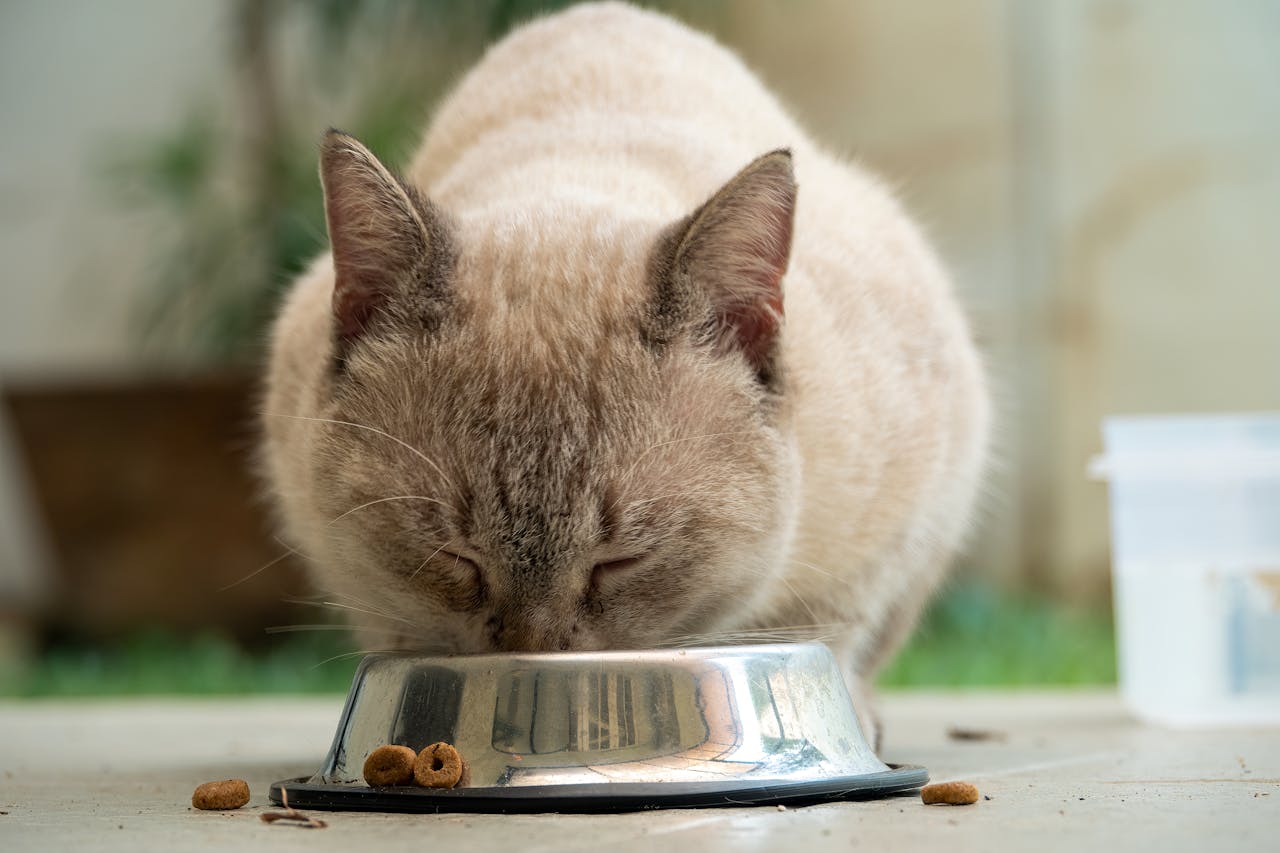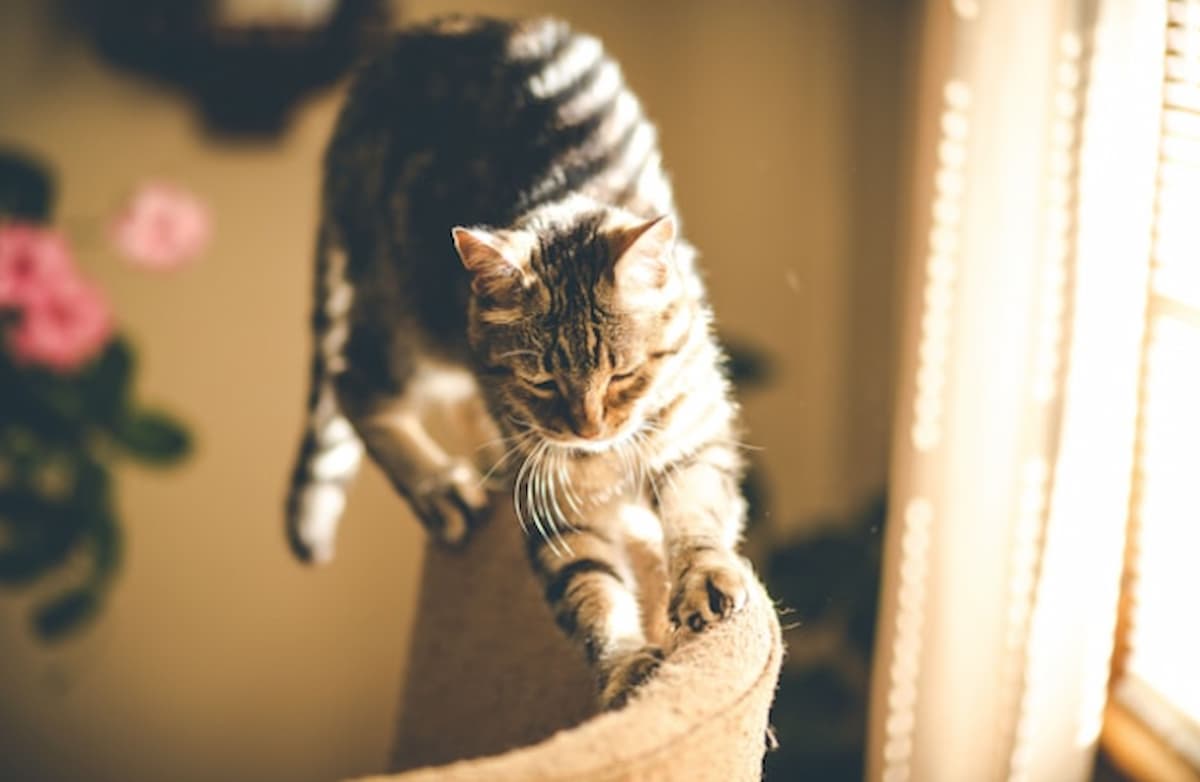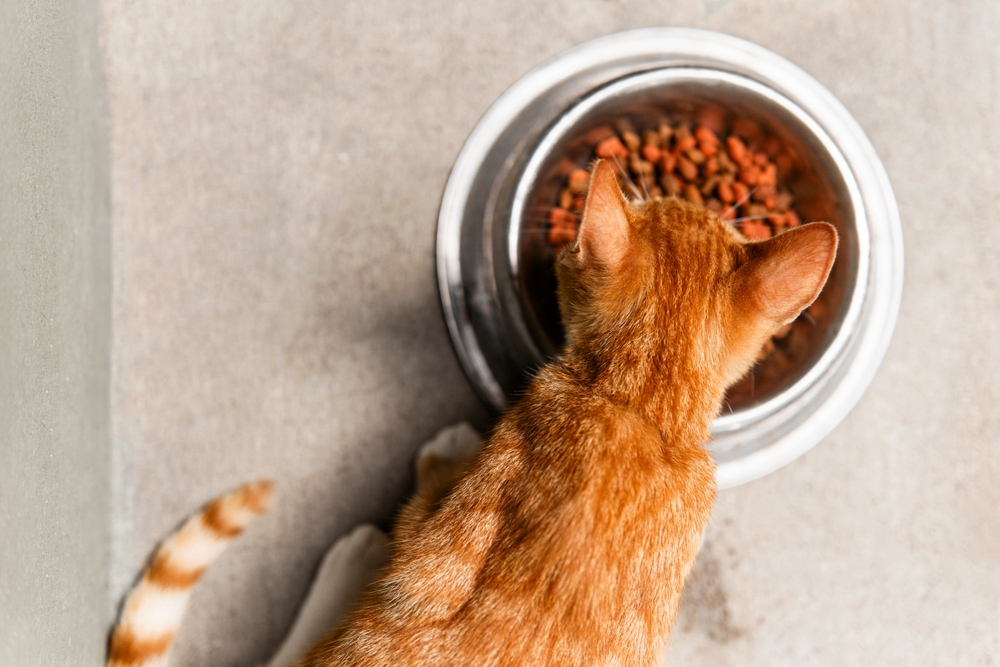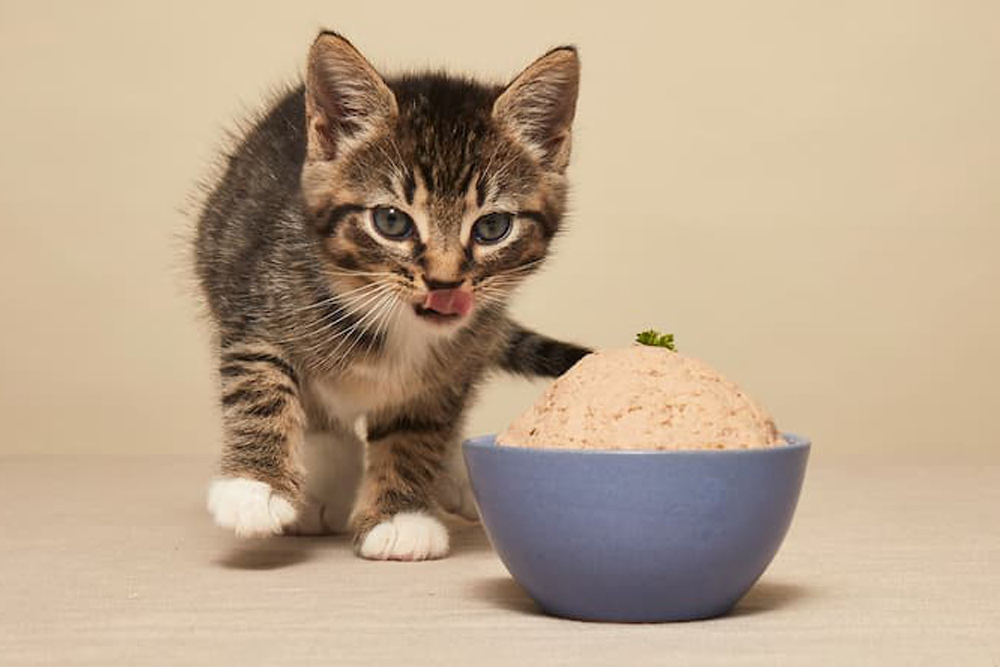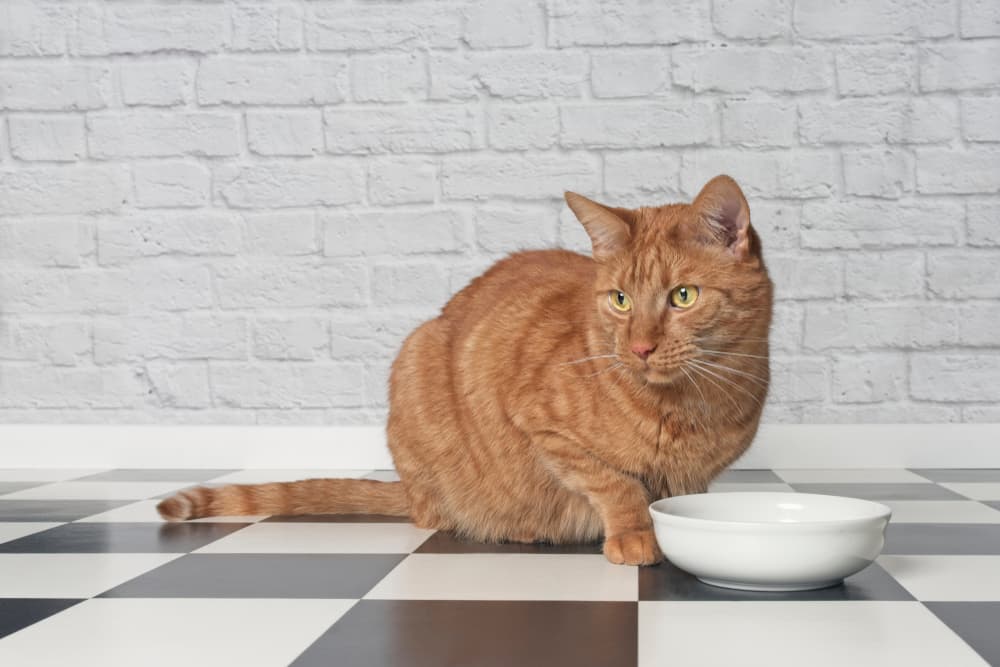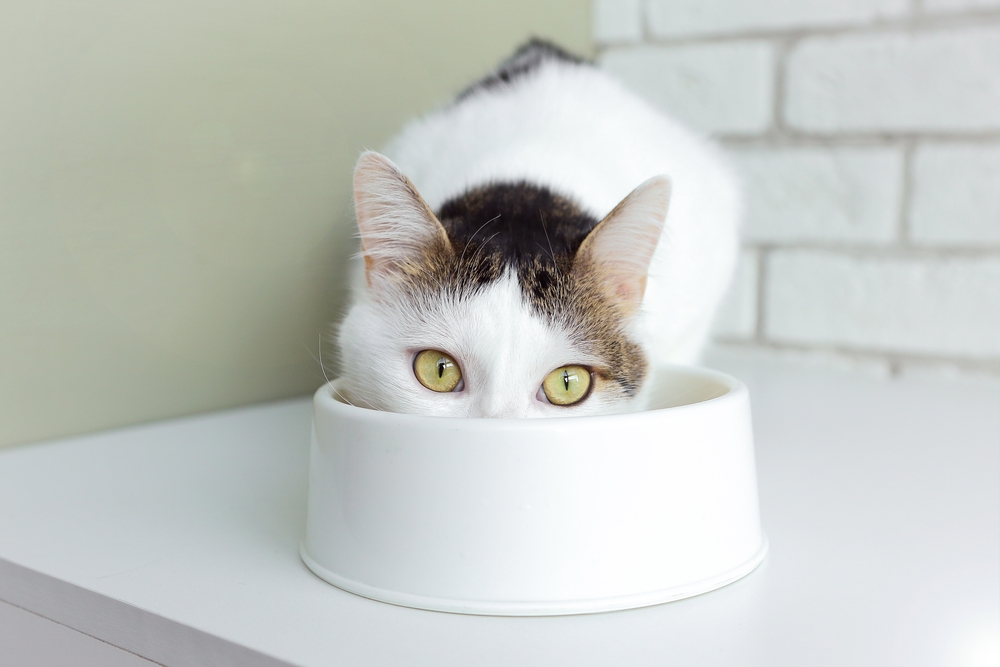7 Best Cheap Cat Foods That Provide High-Quality Nutrition
Updated on February 08, 2024
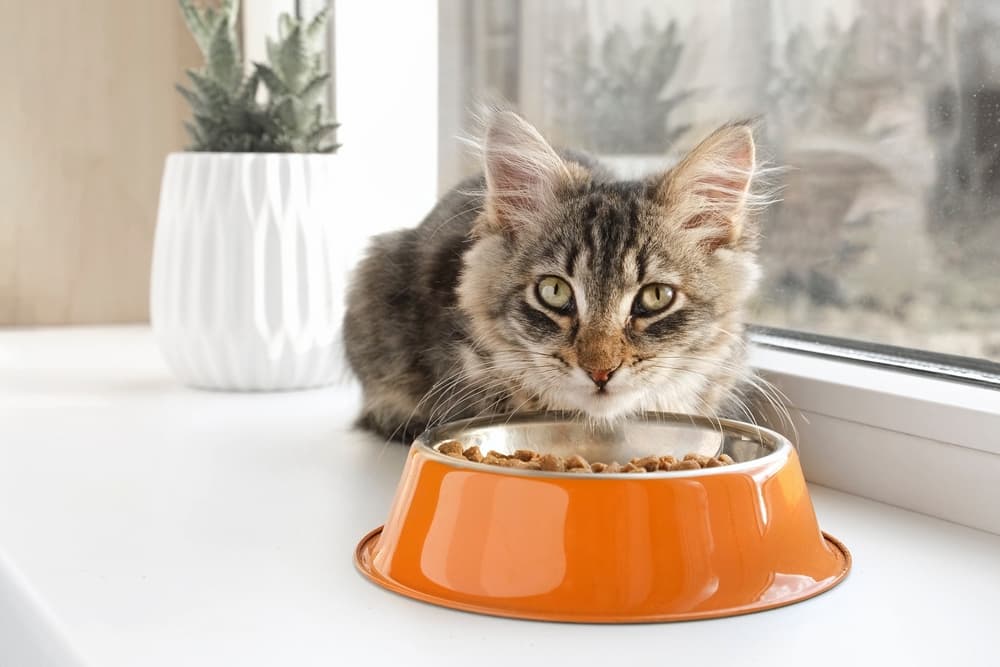
Pet parents know all too well just how expensive the cost of caring for a cat can be. And with pet food companies hinting that our cats should eat a meal that is as good or better than what’s on our plate, it can almost feel irresponsible to reach for the grocery-store brand kibble or cheap cat food. (Spoiler alert: it’s not.)
According to recent surveys, 30 percent of pet parents say they’re more in tune with their pet’s health than ever. And 88 percent are taking preventive measures to protect their pet’s health, which starts with what’s in the food bowl [1].
Current trends in pet food focus on serving pets top-of-the-line food that looks and sounds like something a human would feel comfortable eating. It’s called premiumization, and with premiumization comes premium price tags.
However, a higher price doesn’t necessarily mean higher quality. Dr. Bruce Kornreich, director of the Cornell Feline Health Center at the Cornell University College of Veterinary Medicine explains it like this: “There are certainly quality, low-cost cat foods on the market. There are also higher-cost cat foods that may not be such high quality. In other words, the cost may not correlate with the true nutritional quality of the food.”
Here’s how to know if what you’re buying is worth the price, plus our selection of seven high-quality, cheap cat foods that won’t break the bank.
Our Top Picks
All featured products are chosen at the discretion of the Vetstreet editorial team and do not reflect a direct endorsement by the author. However, Vetstreet may make a small affiliate commission if you click through and make a purchase.
- Best Affordable Cat Food Overall: Purina Cat Chow Complete
- Best Affordable Dry Cat Food: Rachael Ray Nutrish Real Chicken & Brown Rice Recipe
- Best Affordable Wet Cat Food: Dave’s Naturally Healthy & Delicious
- Best Affordable Kitten Food: Purina Fancy Feast Kitten Classic Paté
- Best Affordable Limited-ingredient Cat Food: Instinct Limited Ingredient Wet Cat Food
- Best Affordable Freeze-Dried Cat Food: Stella & Chewy’s Dinner Morsels
- Best Affordable Frozen Raw Cat Food: Darwin’s Natural Foods
How We Made Our Selections of Affordable Cat Food Brands
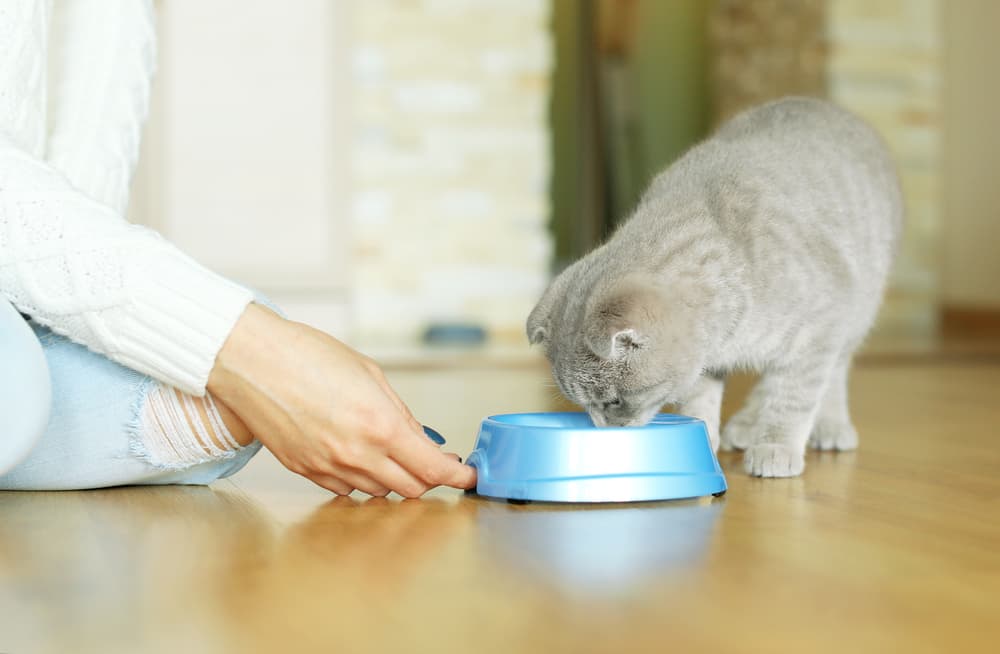
While Dr. Kornreich and other members of the Cornell Feline Health Center team can’t endorse specific pet food brands, with his and Dr. Shoveller’s expert guidance, we rounded up the best low-cost cat food for every type of kitty at each stage of life, taking the following into consideration.
Nutrition. We factored in nutritional values and caloric density, and made sure our recommended cat foods meet the Association of American Feed Control Officials (AAFCO) standards for a complete and balanced meal.
Quality control. We also looked at important quality control standards, highlighting companies that focus on maintaining the excellence of their food.
Ratings and reviews. What other cat parents say is important, too. So, we considered real reviews to get a well-rounded view of each option.
Price. Obviously cost was high on our radar here. We can’t guarantee your finicky feline will love her new reasonably priced cat food – but for the low cost of these high-quality selections, trial and error will be lighter on the wallet.
7 Best Cheap Cat Foods That Provide High-Quality Nutrition
From wet to dry, frozen to freeze-dried, here are our picks for the best cheap cat food that’s healthy:
Best Affordable Cat Food Overall
Our pick: Purina Cat Chow Complete
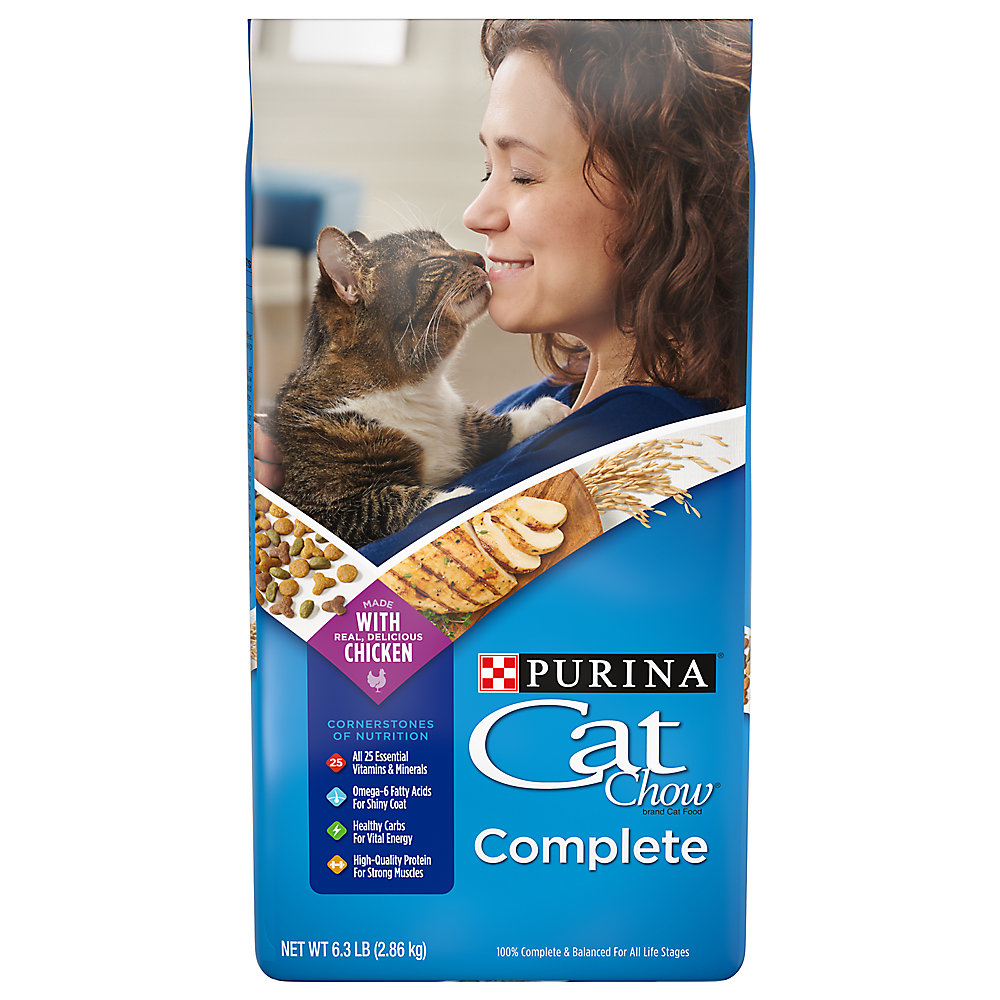
According to Dr. Shoveller, grocery store brands like Purina Cat Chow are where you’ll find the most bang for your buck: they’re affordable, available almost anywhere you shop, and typically stamped with the AAFCO seal of approval. Purina leads in pet nutrition, with on-staff veterinarians formulating every recipe and the Purina Institute working hard to advance our understanding of pet health and nutrition. For these reasons, it gets our vote for best cheapest cat food on our list.
Every crunch of this affordable cat food is nutritionally complete for all life stages. It’s made extra delicious with beef fat and liver flavoring that even the most finicky of felines are sure to love. And thanks to Purina’s interactive ingredient list, there are no mystery ingredients in this recipe.
Pros
- Contains 32% protein to promote strong muscles and healthy joints
- Includes 25 essential vitamins and minerals
- Meets the nutritional levels established by the AAFCO Cat Food Nutrient Profiles for all life stages
- Manufactured at Purina’s Missouri plant, which means more quality control in every bag
- Under $11 for 6.3 lbs, or $1.72 per lb
Cons
- Pet parents and their cats love this formula, but many wish it was available in more flavors to curb boredom at the bowl
Best Affordable Dry Food
Our pick: Rachael Ray Nutrish Real Chicken & Brown Rice Recipe
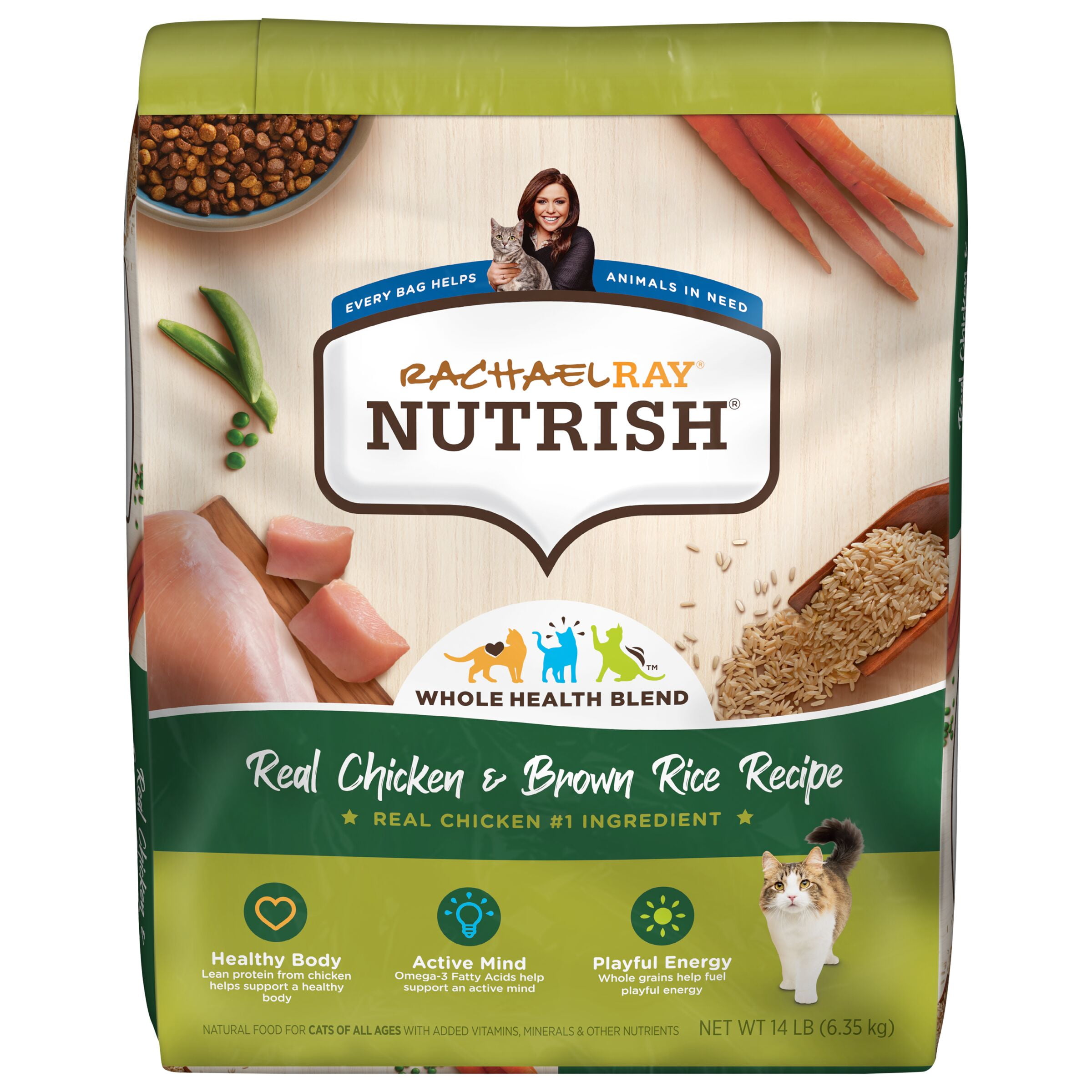
We love seeing a protein as the first ingredient of any pet food recipe, which is one of the reasons this tasty option from Rachael Ray Nutrish snagged a spot on our list. Ideal for cats in all life stages, this kibble is rounded out with ingredients like fiber-forward brown rice and beet pulp to help promote healthy digestion. Plus, it contains no wheat, soy, or artificial flavors, making it great for kitties with allergies.
Pros
- Chicken is the first ingredient listed; also available in salmon
- Brown rice aids in digestion
- Made without wheat, soy, or artificial flavors/preservatives
- Company utilizes independent third parties to assess and audit food safety programs at each manufacturing facility
- Meets AAFCO standards
- Made in the USA
- A little under $27 for 14 lbs, which comes to $1.89 per pound
Cons
- This particular recipe is only available in two flavors
Best Affordable Wet Food
Our pick: Dave’s Naturally Healthy & Delicious
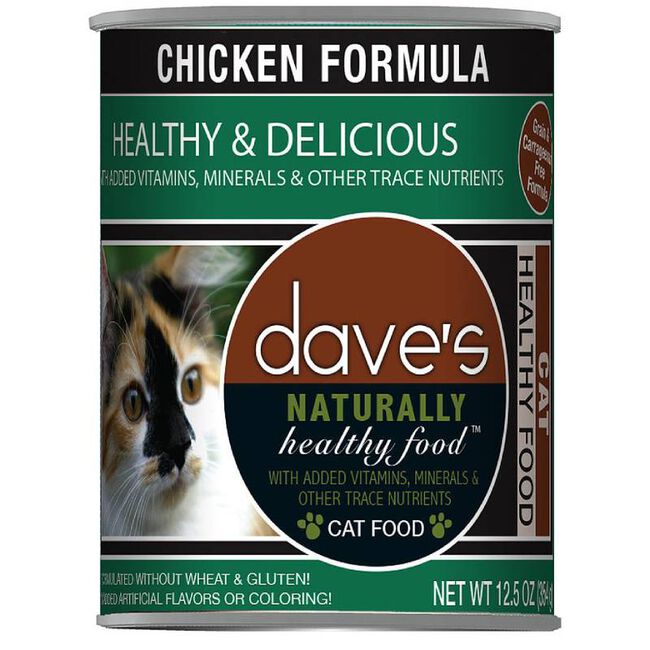
When it comes to affordable wet cat food for adult cats, it’s hard to beat the offerings of Dave’s Pet Food. Founded over 20 years ago by dog dad Dave with the help of a veterinary nutritionist, the brand has consistently produced nutritionally complete food at a low price point. In this recipe, you’ll find ingredients like chicken, chicken broth, chicken liver, and turkey. Plus, the larger 12.5 oz cans makes Dave’s a great value. In terms of cheap wet cat food, we like that this formula has no wheat or gluten and pet parents can feel good serving it.
Pros
- Formulated with Omega-3 and Omega-6 fatty acids
- Free from grains, artificial flavors and colors, and carrageenan
- Meets AAFCO standards
- USA made
- About $36 for twelve 12.5 oz cans, which comes to 0.24 cents per oz
Cons
- Pet parents note that the cans can be waterier than expected, which has its pros and cons. But Dr. Shoveller notes that “water is so important and overlooked in cats. If I have any doubts [that a cat isn’t drinking enough water], I’m recommending wet foods.”
Best Affordable Kitten Food
Our pick: Purina Fancy Feast Kitten Classic Paté
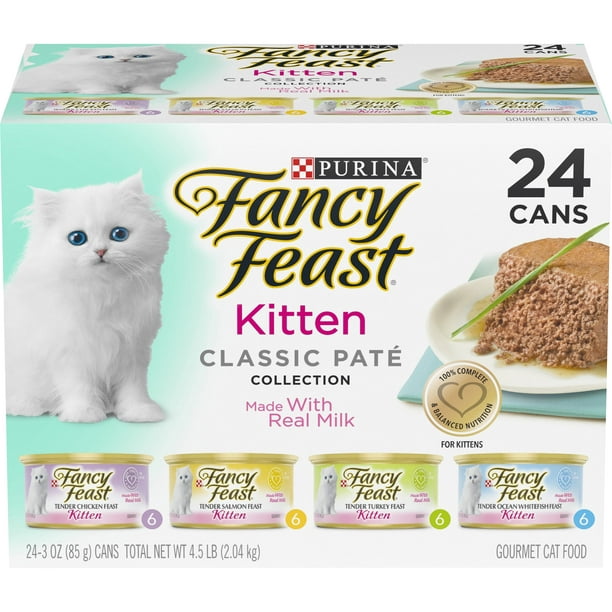
Your kitten is going to eat a lot, and Fancy Feast is a good, affordable option. This soft, hydrating wet food recipe is formulated with essential vitamins and minerals to ensure healthy development. Purina promises that every ingredient is blended for a purpose, from strong bones and muscles to a healthy immune system and the development of brain and eye functions.
Pros
- Smooth paté for easy consumption and weaning
- Available in a variety of flavors and a multipack
- USA-sourced ingredients
- Manufactured at Purina’s Missouri plant
- Meets the nutritional levels established by the AAFCO Cat Food Nutrient Profiles for kittens, so you know you’re serving up the nutrients for your kitten to grow big and strong
- Under $24 for twenty-four 3 oz cans, which comes to .28 cents per oz
Cons
- Variety pack options include whitefish and salmon. Fish can cause allergic reactions in cats and is not recommended as a primary source of protein for them [2].
Best Affordable Limited-Ingredient Food
Our pick: Instinct Limited Ingredient Wet Cat Food
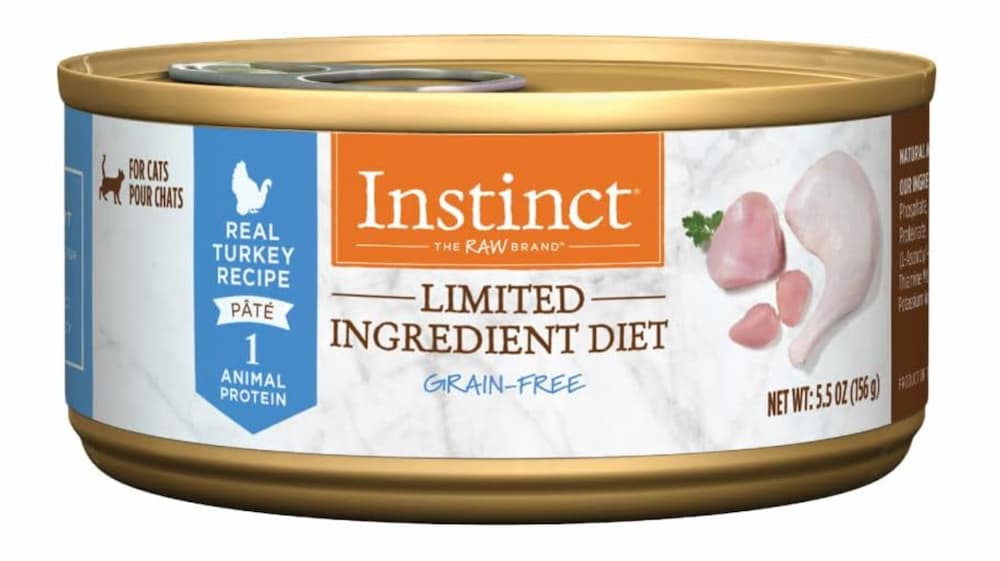
Veterinary visits to get to the bottom of your cat’s sensitive stomach or allergies can be pricey, but high-quality limited-ingredient cat food doesn’t need to follow suit. Instinct’s limited-ingredient recipes are made with one protein and a single vegetable, and without extras like grain, corn, and wheat – all at a reasonable price. Plus, because their recipes have been developed in partnership with the University of Nebraska and PhD-level nutritionists and stamped with the AAFCO statement, you can feel good knowing your cat is getting a complete and balanced meal.
Pros
- Developed in partnership with the University of Nebraska and PhD-level nutritionists
- Simple ingredient list includes one protein and one vegetable
- No grain, potato, corn, wheat, soy, or artificial colors/preservatives
- Tested by an external lab
- Has achieved an “Excellent” Safe Quality Food (SQF) Food Safety rating and an SQF Quality Certification
- Meets AAFCO standards
- Under $30 for twelve 5.5 oz cans, which comes to .47 cents per oz, which really is a good option for best cat food for the price
Cons
- Higher in price than other picks on this particular list, but still a better deal than many alternative options
Best Affordable Freeze-Dried Food
Our pick: Stella & Chewy’s Dinner Morsels

Freeze-dried raw cat foods are a good choice when you’re looking for a shelf-stable, easy-to-travel-with food option. The morsels are high-pressure processed, which means harmful bacteria are destroyed without compromising nutritional benefits. And while freeze-dried cat foods in general tend to be a bit pricier than more traditional types, Stella & Chewy’s is one of the more healthy affordable cat food options. We love Stella & Chewy’s for their product transparency (every certificate of analysis report can be tracked), quality ingredients, and wide selection of responsibly sourced proteins. Plus, if your finicky feline doesn’t like it, the company accepts returns of any unused portion within 14 days of purchase.
Pros
- Every recipe is fortified with added vitamins and minerals, probiotics, and antioxidants
- Made with USA-sourced proteins in the company’s FDA-inspected Wisconsin facility
- Meets AAFCO standards
- Company accepts returns of opened food within 14 days of purchase
- $10.99 for a 3.5 oz bag, which comes to $3.14 an oz
Cons
- Needs to be rehydrated with warm water or unsalted broth before serving
- Higher price point than standard kibble or wet food
Best Frozen Raw Food
Our pick: Darwin’s Natural Pet Products
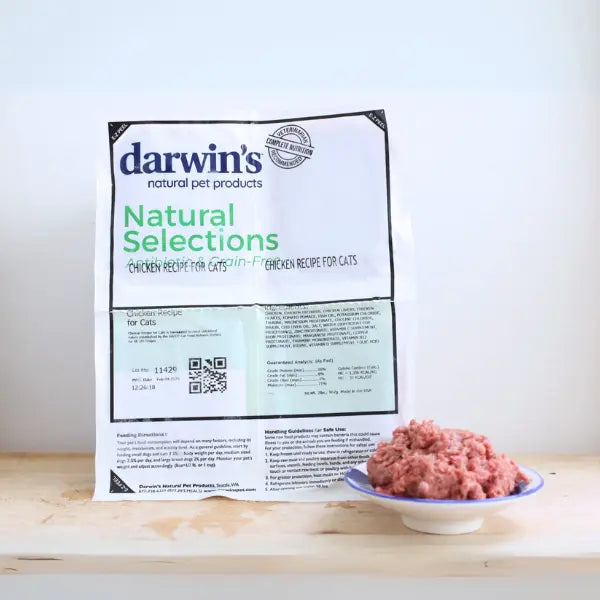
Also a bit pricier than some of the other picks on our list, Darwin’s Natural Pet Products does stand out for its affordable trial price: 10 pounds of raw frozen food delivered to your door for just $14.95. After that, Darwin’s estimates that an 11-pound spayed adult cat with a normal activity level would cost $18.69 to feed each week with Darwin’s. Hop onto the company’s website to input your own cat’s information for a tailored feeding plan, curated by Darwin’s on-staff veterinarians.
Pros
- Manufactured at Darwin’s Seattle, Washington plant for added quality control
- Complete and balanced formulas
- Delivered frozen, straight to your door
- Curated recipes by Darwin’s on-staff veterinarians
- Intelligent Design prescription pet food is available for cats with kidney disease
Cons
- Minimum order of 10 pounds
- Limited proteins available
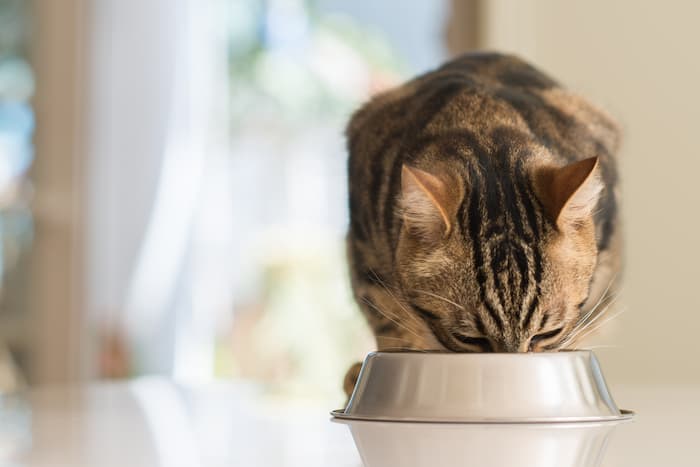
Cheap Good Cat Food: Affordable Doesn’t Mean Bad
Quality is really complex, says Dr. Anna Kate Shoveller, professor and Champion Pet Foods chair in canine and feline nutrition at the University of Guelph. She compares choosing high-quality cat food to shopping for meat at the grocery store. Sure, a T-bone steak is of higher quality than ground meat, but both choices provide the essential nutrients we need.
When it comes to affordable cat food brands that deliver essential vitamins and nutrients, there are a few ingredients that get a bad rap, including by-product meal, fillers, and preservatives. But you shouldn’t always believe the marketing.
By-Product Meal
“This notion that by-products are ‘bad’ is misleading,” Dr. Kornreich says. By-products are cost-effective ingredients that are upcycled from the human food industry. And they’re not all made the same. They range from high concentrations of bone to chicken breast meat mixed with other animal parts. And by the way, the whole animal is a biologically appropriate food for cats (even if we wouldn’t dare eat it).
If you’re wondering how to tell the quality of a by-product meal, look at the ash content. Ash is minerals from bone. So, the higher the ash content, the more bone-dense the food may be. If the label doesn’t include the nutritional profile, “contact the company and ask the specific concentrations in their by-product,” Dr. Kornreich suggests.
Fillers
Fillers can include corn, rice, and potatoes. “Fillers, in terms of the word, would suggest it holds no nutrient value for the animal,” Dr. Shoveller says. But she adds that it’s just not true. For example, “animals – dogs and cats – can use carbohydrates to form glucose, and glucose can be used for energy. So, these ingredients all have a value, they just all have a different cost coming in.”
However, Dr. Kornreich says to look out for ingredients that have no proven benefits, like certain flavorings, apricots, and flaxseed.
Preservatives
“What’s worse, preservatives or rancid food?” Dr. Kornreich asks. “Preservatives are not inherently bad; they’re the things that make it so that cat food can remain nutritionally complete, balanced, and healthy and not spoiled or dangerous.” And, he adds, synthetic preservatives are typically more effective at keeping foods fresh than natural preservatives.
Dr. Kornreich also offers a warning about buzzwords like human-grade ingredients. Human-grade foods “may not garner any additional benefit for the well-being of the cat. Just because it says human-grade, doesn’t mean it’s better for the cat,” he says. Plus, jumping through the hoops of certifying that ingredients are human-grade and meet AAFCO standards is expensive – a cost that’s passed onto the consumer.
Cheap Cat Food Buyer’s Guide
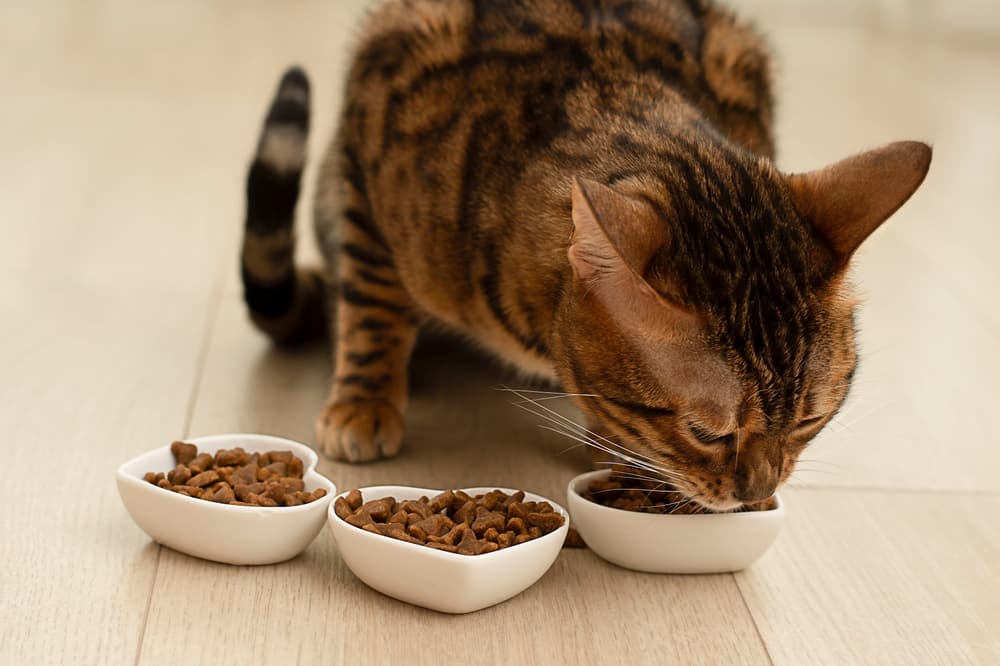
When it comes to what you’re putting in your cat’s body on a daily basis, questions and uncertainty are inevitable. Here are a few things to consider before shelling out your cash for a new cat food, especially regarding inexpensive cat food that is healthy.
Talk with your veterinarian. “Your veterinarian is the best source of information,” Dr. Kornreich says. “[Pet parents] should really be consulting with their veterinarians regarding the cat food that’s appropriate for their specific cat. A kitten should be fed differently than an adult. A cat with renal disease should be fed differently than a healthy cat.” Be sure to chat with your veterinarian to understand the right amount of nutrients your cat needs and how many calories per day she should eat.
Look for an AAFCO statement. Even the cheapest healthiest cat food should have an AAFCO statement. This means the food meets the nutrient requirements set by the AAFCO, or that the company has successfully tested and proven that the food is safe to feed your pet.
Review the nutrient profile. At a minimum, most pet foods list the amounts of protein, fat, fiber, moisture content, and sometimes ash. The caloric information should also be listed. If the company doesn’t list nutrient profiles on the product, or if you want additional information about the ingredients, contact the manufacturer..
Consider quality control standards. According to Dr. Kornreich, a few questions can provide a lot of information on the quality control and assurance of the food:
- Does the manufacturer of the food own the plant? “If they do, they have a tighter ability to control quality,” Dr. Kornreich explains.
- Do they employ a full-time board-certified veterinary nutritionist?
- What specific quality control does the company undertake? “Just saying a food is high quality doesn’t make it high quality,” Dr. Kornreich says.
- Does the company conduct any research, and is the research published?
- When requested, does the company provide a complete nutrient profile?
- Do they disparage other companies? It’s a red flag if companies need to put down other companies to make their products look good.
Purchase an appropriate amount: “I always encourage pet parents not to buy ahead on food,” Dr. Shoveller says. Buying in bulk can save money up front, but improper storage can lead to mold (AKA expensive veterinary visits if eaten). Plus, the longer some types of cat food sit – like an open bag of kibble – the less nutritious it becomes.
Best Inexpensive Cat Food FAQs
Follow the instructions in this post and be sure to read labels. Even if you find a good cat food that is inexpensive, your cat has to like the taste. Never skip on nutrients. You may need to try different formulas to find the one that is both budget friendly and appealing to your cat.
Both wet cat food and dry cat food have their advantages. Dry food for cats tends to be more affordable and last longer. Wet cat food, however, is rich in moisture which is good for hydration. Some pet parents choose both, but it depends on your budget and your cat’s preferences and health needs.
As you can see by our cost differences under each cat food list above, dry cat food tends to be less expensive that wet. Raw food that arrives frozen to your doorstep tends to be costly compared to the other inexpensive cat food brands on our list.
Healthy cheap cat food can be wet or dry, but dry tends to be more affordable. Dry food contains less water and is lighter to ship than wet food. Dry cat food tends to have a longer shelf life and is often produced in larger quantities, thus lower the price point.

